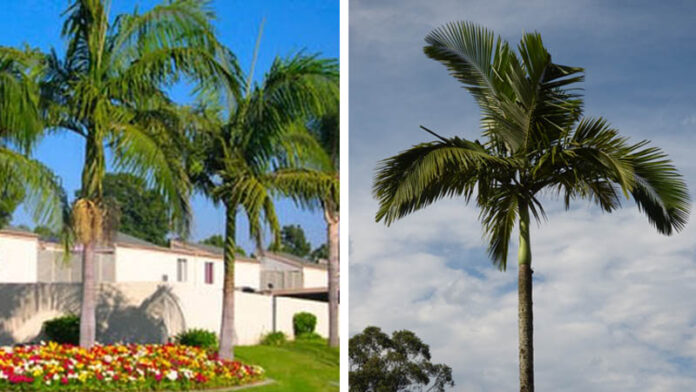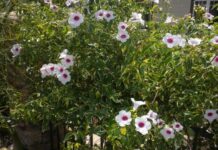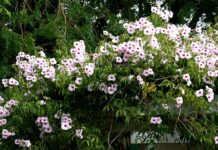
The Alexander Palm or Archontophoenix alexandrae or Alexandra Palm is native to Madagascar and was named after the German explorer Alexander von Humboldt. It is a member of the Arecaceae family and may grow to be 50 feet tall. The tree has a single smooth trunk and its fronds are spirally arranged.
We are continuously on the search for the appropriate plants to enrich our landscapes as landscaping lovers. The Alexander Palm is a plant that has withstood the test of time and remains a favorite option among homeowners. This post will go into the characteristics of this magnificent tree and why it is an excellent addition to any garden.
Why Choose the Alexander Palm Tree for Your Garden?
Low Maintenance
It is popular among homeowners since it is simple to care for. It is drought-tolerant and adaptable to a variety of soil conditions.
Aesthetically Pleasing
It is easy to care for, making it a popular option among homeowners. It is drought tolerant and adaptable to a wide range of soil conditions.
Fast Growth
The tree grows quickly and may add significant height to your landscape in a short amount of time.
Adds Value to Your Property
Because of its beauty and appeal, it adds value to your home. It is an excellent investment for people planning to sell their home in the near future.
How to Care and Grow the Alexander palm tree
Caring for your Alexander Palm Tree is critical to its overall health and growth. This magnificent tree is resilient and takes little care, making it a good choice for homeowners who wish to improve their landscape without spending too much time on it.
Watering
Watering your Palm Tree is essential for its survival and growth. Water the tree once a week, and more frequently during dry times. Overwatering, on the other hand, can cause root rot, so allow the soil to dry before watering again.
Watering the tree’s root zone, which is a circle around the tree trunk, rather than the trunk itself, is critical. This is because if the trunk is consistently moist, it might rot. To adequately water the tree, a soaker hose or drip irrigation system is advised.
Fertilizing
To preserve its health and development, the Tree Alexander Palm requires frequent fertilizer. Fertilize the tree at least once a year, especially in the spring or early summer when it is most active. Use a nitrogen, potassium, and phosphorus slow-release fertilizer. These nutrients are necessary for the growth and development of the tree.
Over-fertilizing can be damaging to the tree, therefore when applying fertilizer, always follow the manufacturer’s guidelines. Also, avoid applying fertilizer near the tree stem, since this might cause root burn.
Pruning
Pruning is required to keep your tree nice and tidy. Dead or damaged fronds should be removed on a regular basis, and new growth that obstructs the view should be pruned. To remove the fronds cleanly and without injuring the tree, pruning shears are advised.
Before new growth begins, the optimum time to trim the tree is in late winter or early spring. This permits the tree to recuperate from trimming prior to the start of the growth season.
Protection from Cold Weather
Cold temperatures might harm your palm tree because it is a tropical plant. It is critical to preserve the tree from frost if you live in a cold climate. During the winter, wrap the tree in blankets or burlap to keep it warm.
It is also critical to maintain the soil wet throughout the winter months to avoid drying out the tree. A layer of mulch at the base of the tree can aid in moisture retention and keeping the roots warm.
It is a fantastic addition to any landscape, and it is a favorite option among homeowners because to its minimal maintenance needs. To maintain the tree’s development and overall health, it must be watered on a regular basis, fertilized, pruned, and protected from cold weather. With appropriate care, your Alexander Palm Tree will thrive and add a tropical touch to your yard for many years.
Alexander tree palm pests and diseases
Although it is a robust and low-maintenance plant, it is prone to a number of pests and diseases. Early detection and treatment of these problems is critical to preventing long-term tree harm. We’ll go over some of the most common pests and illnesses that harm your tree, as well as how to cure them, in this part.
Pests:
Spider Mites
A frequent pest that can harm the Alexander Palm Tree is spider mites. They are small, red or brown-colored insects that can cause severe damage to the tree. Spider mites feed on the undersides of leaves, sucking out the sap and causing discoloration, withering, and, in severe cases, death of the afflicted leaves.
Spray the tree with horticultural oil or insecticidal soap to cure spider mites. These treatments have the ability to smother the mites and prevent future infection. To avoid tree damage, it is critical to follow the manufacturer’s recommendations while using these items.
Mealybugs
Another frequent pest that can harm the Alexander Palm Tree is mealybugs. They are little, white insects that can cause leaf deformation, discoloration, and eventual leaf death. Mealybugs feed on tree sap and emit a sticky substance called honeydew, which attracts other pests and promotes the formation of sooty mold.
Insecticidal soap or horticultural oil can be used to treat mealybugs. You may also physically remove the mealybugs with a gentle brush. To avoid additional damage, monitor the tree for mealybugs on a regular basis and treat any infestation as soon as possible.
Diseases:
Fusarium Wilt
Fusarium wilt is a fungus that can harm your palm tree. It is caused by a fungus that enters the tree via the roots and spreads to the trunk and leaves. The disease can cause leaf browning, wilting, and final leaf death.
To treat Fusarium wilt, you can apply a fungicide to the soil around the tree. It’s essential to follow the manufacturer’s instructions when using these products and to remove any infected leaves or fronds immediately to prevent the disease from spreading.
Bud Rot
Another fungal disease that can damage your palm tree is bud rot. It is caused by a fungus that enters the tree through the roots or trunk. The illness can cause the tree’s core bud to decay, resulting in the tree’s mortality.
To treat bud rot, you should remove the affected fronds or leaves and apply a fungicide to the soil around the tree. It’s also essential to prevent overwatering the tree as the excess moisture can promote fungal growth.
Although it is a beautiful and resilient plant, it is subject to pests and illnesses. Early detection and treatment of these problems is critical to preventing long-term tree harm. Regular tree inspections and timely treatment of any problems can help maintain your tree healthy and growing.
FAQs
How tall do Alexander palms grow?
May reach a height of 40 feet and a spread of 10-15 feet. In cultivation, they often reach a height of 20-25 feet.
Is Alexander palm an indoor plant?
Indoors, it may be cultivated in bright, indirect light. They are, however, primarily cultivated outside in tropical and subtropical climates.
Do Alexander palms like full sun?
Yes, this tree prefer full sun and require at least 6 hours of direct sunlight per day to thrive.
Where do Alexander palms come from?
These trees are native to the rainforests of Queensland, Australia.
How quickly do Alexander palms grow?
These are moderate to rapid growers, with an average annual growth rate of 1-2 feet.
How long does it take for an alexandra palm to grow?
It normally takes 5-10 years to mature, depending on growth circumstances and care.
Can Alexander palms grow in pots?
Yes, it may be planted in containers, but they must be in big containers with well-draining soil to avoid root rot.
Is Alexander Palm self cleaning?
Yes, it’s self-cleaning, meaning that old fronds will naturally fall off the tree as new ones grow in.
Is Alexander Palm cold hardy?
These trees are not cold resistant and should only be grown in USDA hardiness zones 10-11, where temperatures do not fall below 30°F.
Do palm trees grow naturally in Greece?
Palm trees are not native to Greece, as the country’s climate is not suitable for most tropical and subtropical palms.
Is Alexander palm fruit edible?
Although palm Alexander fruit is theoretically edible, it is not widely consumed and is not regarded as a food source.
How do you identify a Alexander palm?
The feather-like fronds that develop in a circular arrangement around the top of the trunk distinguish palms Alexander. The fronds are typically light green to silver-green in color and can reach a length of 10 feet.
What is the rarest palm tree in the world?
The Encephalartos woodii, which is endemic to South Africa and is critically endangered in the wild, is the world’s rarest palm tree.
What is the easiest palm to care for?
The simplest palm to care for is determined by growth circumstances and personal preferences. However, other palms that are simple to cultivate are the Areca palm, the Parlor palm, and the Pygmy date palm.
Is King Palm same as Alexander palm?
No, the King Palm (Archontophoenix cunninghamiana) is not the same as the Alexander palm (Archontophoenix alexandrae). While they are closely related and have a similar look, their growth patterns and development requirements differ significantly.
Do Alexander palms have seeds?
Yes, it produce seeds, which can be collected and planted to grow new trees.
Are any palm trees poisonous?
While most palm trees are not poisonous, some, like the Sago palm (Cycas revoluta), can be hazardous to people and pets if consumed. Before planting any palm tree in a landscape or indoor space, it is critical to investigate its possible toxicity.
Conclusion
The Tree Alexander Palm is a magnificent addition to any yard, and it is a favorite option among homeowners because to its minimal care needs. It is an excellent investment due to its symmetrical look, rapid growth, and capacity to add value to your house. With appropriate care, your Palm Tree will thrive and add a tropical touch to your yard for many years.







![Rose Names And All Rose Types – The Most Detailed Guide [2022] rose names](https://www.yardious.com/wp-content/uploads/2018/05/rose-names-100x70.jpg)











